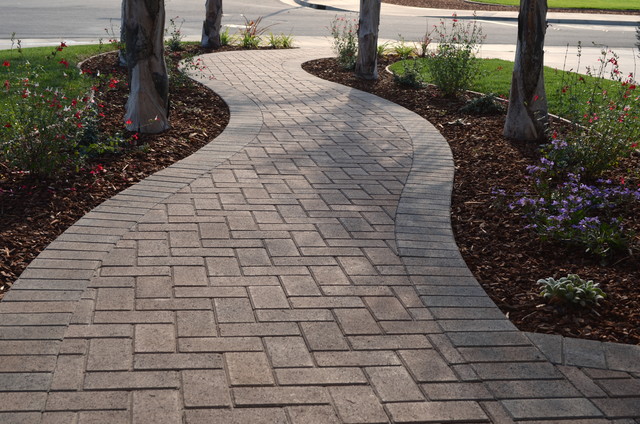
15 common Stains and how to remove them from interlocking pavers
When properly installed, interlocking concrete pavers have very low maintenance. Under foot and vehicular traffic, they can become exposed to dirt, stains and wear. This is common to all pavements.
Commercial stain removers available specifically for concrete pavers or cast in place concrete provide a high degree of certainty when removing stains. Many stains can be removed while still minimizing the risk of dis-colouring or damaging the pavers. The container label often provides a list of stains that can be removed. If there are questions, the cleaner supplier should be contacted for help with determining the effectiveness of the chemical in removing specific stains.
Identify the types of stains prior to purchasing a cleaner. Test a small area in an inconspicuous spot to see how effective the cleaner is and if it will dis-colour the paver. Some stains may require repeated applications of the remover to achieve effective cleaning. This is often the case for deep set oil stains.
With all stain removers the label directions and warnings should be read and carefully followed for all precautions.
Start removal of stains at the bottom if the area is sloped, and work your way up in manageable sections. By working up the slope, cleaning fluids will drain down the pavement. This technique assists in uniform removal while allowing the used cleaner to be rinsed away consistently. The surface remains dry ahead of the cleaner-soaked wet areas, allowing better visibility of the stains to be removed. Take care in selecting and applying cleaning products, as acidic ones may harm vegetation and grass. These cleaners should not run onto vegetation. When using strong acidic stain removers or cleaners that might drain onto vegetation, saturate the vegetation with water prior to using the cleaners. This will minimize absorption of cleaner and rinse water and reduce risk of damage to vegetation.
Removing of Common Stains
There are commercially available cleaning products specifically designed for concrete pavers. Many have been developed through extensive laboratory and field testing to ensure cleaning effectiveness. These chemicals should be used whenever possible. Using cleaning chemicals made for specific stains will remove the uncertainty of attaining the proper mixture of chemicals. If you cannot find a commercial stain removal product, you can try some of the mixtures listed below, however remember that some of the treatments involve hazardous chemicals and you should use specific precautions. Most involve typical household chemicals. Searching the internet using the key phrases mentioned below can provide additional information. I would advise to use cleaners specifically made to remove stains that commonly occur on concrete pavers. They will likely be more effective.
- Asphalt and emulsified asphalt—Chill with ice (if warm outside), scrape away and scrub the surface with scouring or abrasive powder. Rinse thoroughly with water.
- Cutback asphalt and roofing tar—Use a poultice made with talc or diatomaceous earth (Kitty Litter). Mix with kerosene, scrub, let dry and brush off. Repeat as needed.
- Blood, candy, ketchup, mustard, grease drippings from food—For stubborn stains, apply liquid detergent full strength and allow it to penetrate for 20 to 30 minutes. Scrub and rinse with hot water. Removal is easier if these stains are treated immediately.
- Caulking—Scrape off excess and scrub with a poultice of denatured alcohol. Rinse with hot water and detergent.
- Paint—Fresh paint should be mopped up immediately with rags or paper towels by blotting. Do not wipe as this will spread the paint and extend the job of removal. If the paint is latex and water based, soak and then scrub the area with hot water, scouring powder and a stiff brush until no more improvement is seen. Let the remaining paint dry and remove as described below.
- Dried paint—Scrape any excess oil based paint, varnish or water based latex paint off the surface. Apply a commercial paint remover and let it sit for 20 to 30 minutes. Loosen with gentle scrubbing. Do not rub the loosened paint into the surface of the paver. Instead, blot up the loosened paint and thinner. Repeat as necessary.
- Acrylic latex caulk—follow guidelines for removal of latex paint.
- Chewing gum—Same as caulking, or scrub with naphtha.
- Clay soil—Scrape off dry material, scrub and rinse with hot water and strong detergent.
- Creosote—Apply a poultice with paint thinner and talc. Scrub and allow to dry. Scrape off, scrub with scouring powder and rinse with water.
- Leaf, wood rot, or tobacco stains—apply household bleach and scrub with a stiff bristled brush.
- Mortar—Let harden and carefully remove hardened spots with a trowel, putty knife or chisel.
- Smoke—Scrub with a poultice of talc with bleach diluted 1:5 with water. Rinse with water.
- Oil or grease that has penetrated—Mop up any excess oil with rags. Cover the area with oil absorbent (kitty litter). Talc, fuller’s earth, diatomaceous earth can be used. Leave it on the stain for a day then sweep up.
- Tire skid marks—Scrub black area with water, detergent and scouring powder. In the case of small stained areas, removal and replacement with new pavers may be an option.
In the case of small stained areas, removal and replacement with new pavers may also be an option.
This information should help you maximize the beauty and life span of you interlocking pavers for years to come.